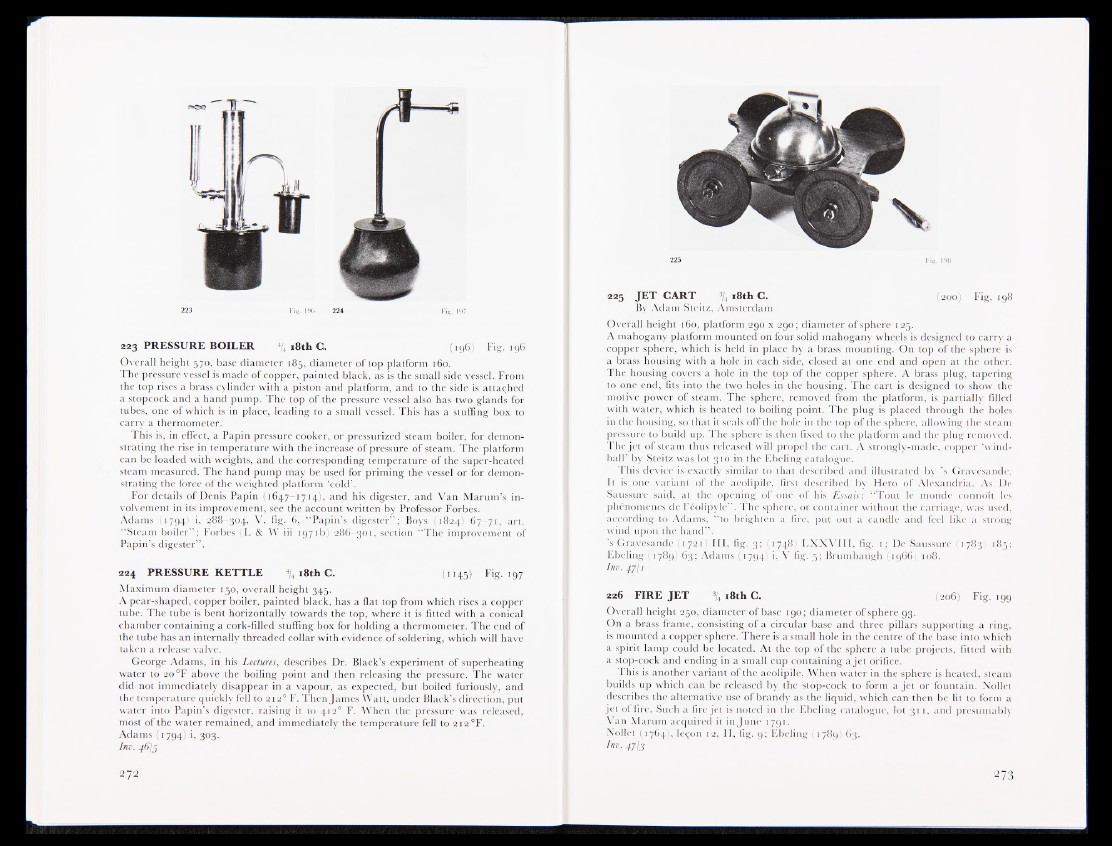
2 2 3 Fig. 196 2 2 4 Fig. 197
223 PRESSURE BOILER 4/4 18th C. (196) Fig. 196
Overall height 570, base diameter 185, diameter of top platform 160.
The pressure vessel is made of copper, painted black, as is the small side vessel. From
the top rises a brass cylinder with a piston and platform, and to the side is attached
a stopcock and a hand pump. The top of the pressure vessel also has two glands for
tubes, one of which is in place, leading to a small vessel. This has a stuffing box to
carry a thermometer.
This is, in effect, a Papin pressure cooker, or pressurized steam boiler, for demonstrating
the rise in temperature with the increase of pressure of steam. The platform
can be loaded with weights, and the corresponding temperature of the super-heated
steam measured. The hand pump may be used for priming the vessel or for demonstrating
the force of the weighted platform ‘cold’.
For details of Denis Papin (1647-1714), and his digester, and Van Marum’s involvement
in its improvement, see the account written by Professor Forbes.
Adams (1794) i, 288-304, V, fig. 6, “ Papin’s digester” ; Boys (1824) 67-71, art.
“ Steam boiler” ; Forbes (L & W iii 1971b) 286-301, section “The improvement of
Papin’s digester” .
224 PRESSURE KETTLE 4/4 18th C. (1145) Fig. 197
Maximum diameter 150, overall height 345.
A pear-shaped, copper boiler, painted black, has a flat top from which rises a copper
tube. The tube is bent horizontally towards the top, where it is fitted with a conical
chamber containing a cork-filled stuffing box for holding a thermometer. The end of
the tube has an internally threaded collar with evidence of soldering, which will have
taken a release valve.
George Adams, in his Lectures, describes Dr. Black’s experiment of superheating
water to 20 °F above the boiling point and then releasing the pressure. The water
did not immediately disappear in a vapour, as expected, but boiled furiously, and
the temperature quickly fell to 2120 F. Then James Watt, under Black’s direction, put
water into Papin’s digester, raising it to 412° F. When the pressure was released,
most of the water remained, and immediately the temperature fell to 2iq°F.
Adams (1794) i, 303.
Inv. 46)5
225
225 JET CART % 18th C. (200) Fig. 198
By Adam Stcitz, Amsterdam
Overall height 160, platform 290 x 290; diameter of sphere 125.
A mahogany platform mounted on four solid mahogany wheels is designed to carry a
copper sphere, which is held in place by a brass mounting. On top of the sphere is
a brass housing with a hole in each side, closed at one end and open at the other.
The housing covers a hole in the top of the copper sphere. A brass plug, tapering
to one end, fits into the two holes in the housing. The cart is designed to show the
motive power of steam. The sphere, removed from the platform, is partially filled
with water, which is heated to boiling point. The plug is placed through the holes
in the housing, so that it seals olf the hole in the top of the sphere, allowing the steam
pressure to build up. The sphere is then fixed to the platform and the plug removed.
The jet of steam thus released will propel the cart. A strongly-made, copper ‘wind-
ball’ by Steitz was lot 310 in the Ebeling catalogue.
This device is exactly similar to that described and illustrated by ’s Gravesande.
It is one variant of the aeolipile, first described by Hero of Alexandria. As De
Saussure said, at the opening of one of his Essais: “Tout le monde connoît les
phénomènes de l’éolipyle” . The sphere, or container without the carriage, was used,
according to Adams, “ to brighten a fire, put out a candle and feel like a strong
wind upon the hand” .
’s Gravesande (1721) III, fig. 3; (1748) LXXVIII, fig. 1; De Saussure (1783) 185;
Ebeling (1789) 63; Adams (1794) i, V fig. 5; Brumbaugh (1966) 108.
Inv. 4711
226 FIRE JET 3/4 18th C. (206) Fig. 199
Overall height 250, diameter of base 190; diameter of sphere 93.
On a brass frame, consisting of a circular base and three pillars supporting a ring,
is mounted a copper sphere. There is a small hole in the centre of the base into which
a spirit lamp could be located. At the top of the sphere a tube projects, fitted with
a stop-cock and ending in a small cùp containing a jet orifice.
This is another variant of the aeolipile. When water in the sphere is heated, steam
builds up which can be released by the stop-cock to form a jet or fountain. Nollet
describes the alternative use of brandy as the liquid, which can then be lit to form a
jet of fire. Such a fire jet is noted in the Ebeling catalogue, lot 311, and presumably
Van Marum acquired it in June 1791.
Nollet (1764), leçon 12, 11, fig. g; Ebeling (1789) 63.
!nv. 4713